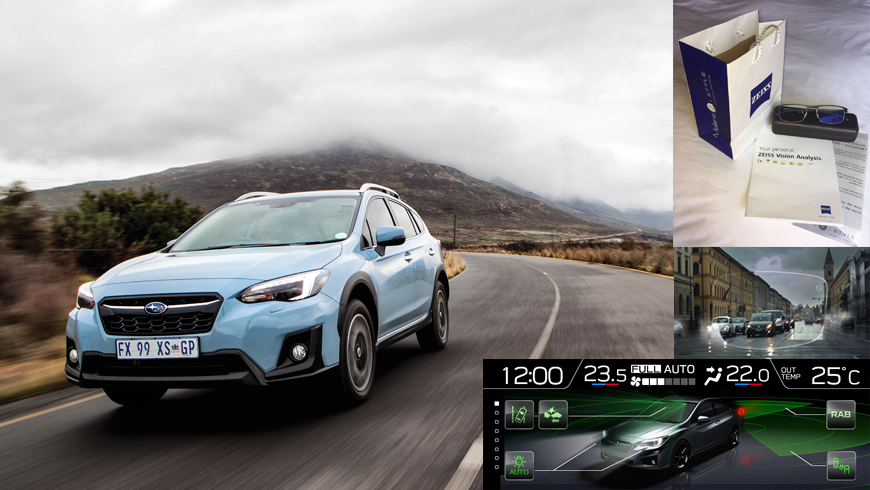Clear vision remains a prerequisite for any driver. Paul van Gass took an eye test and donned a pair of Zeiss Drivesafe glasses to test the EyeSight system of Subaru, recently introduced in the new XV.
For any road trip there are two crucial requirements: A safe and reliable vehicle, and a driver with good vision. Without these, you will not get far.
Keeping in mind that on average 83% of spectacle lens wearers also drive, it follows that these daily road users (as well as those not wearing spectacles) need to get their eyesight tested regularly.
This may well be done when renewing ones drivers’ licence every five years, but anyone who has done an eye test at a government testing centre will know that the equipment used is not exactly state-of-the-art. It also does not give one any clear indication of the state of your eyesight, nor does it specify what type of lenses you may need to improve your sight.
The Zeiss experience
In order to determine the state of your eyes, the first step should always be to visit a reputable optician. This is where the company Carl Zeiss AG, a 160-year-old German manufacturer of glasses, camera lenses, and other optical systems, comes in.
Zeiss has developed a personal vision analysis system called i.Scription, which includes tests such as i.Profiler Plus to generate an in-depth profile of your sight; a personal eye map, if you will. It also evaluates your visual acuity, analyses how your eyes work together, and measures your face for perfect lens positioning.
Zeiss also now offers lenses specifically for driving, available in both single vision and progressive lens types. Called ‘DriveSafe’, these lenses essentially reduce daytime glare, but also reduces glare emanating from fog, rain, and oncoming headlights at night.
Subaru Safety
The new second-generation Subaru XV has recently been launched in South Africa. Apart from Subaru’s Symmetrical All-Wheel Drive system and a new 2.0-litre direct injection Boxer engine, the XV now comes standard with a suite of safety and hazard avoidance features.
The XV is also the first model locally with the EyeSight Driver Assistance System. It offers four types of driver assistance functions designed to reduce or circumvent crashes caused by driver error, and to reduce or circumvent collisions caused by driver fatigue.
The system detects vehicles, pedestrians, cyclists, and other potential hazards up to 110 metres in front of the vehicle. Using data from the stereo cameras, the engine, brakes, and transmission, the system has the following functions: Pre-Collision Braking; Pre-Collision Throttle Management; Lane Departure and Sway Warning; and Adaptive Cruise Control and Reverse Automatic Braking.
Last year, all Subaru vehicles equipped with EyeSight were awarded the highest safety ratings ever achieved from the Insurance Institute for Highway Safety (IIHS Top Safety Pick) and this year the XV achieved the highest score on record in the Japanese New Car Assessment Program (JNCAP) crash tests. It also scored five stars in the Euro NCAP and Australian ANCAP ratings.
Evaluation
But, do these technologies work? Swopping my normal glasses for a brand-new DriveSafe pair in a lightweight, modern Mykita frame, I set out to test them at night behind the wheel of a Premium spec XV 2.0i-S ES model with Lineartronic transmission.
Cruising down the notorious N2 highway and some badly lit backroads, I could certainly detect a difference, perhaps because I was consciously looking for subtle differences in glare and low light clarity.
The primary differentiation was glare levels from streetlights and headlights from oncoming cars. It may not be as apparent to those switching permanently from normal to DriveSafe lenses, as your brain soon adjusts to the reduced glare level and then one takes it for granted. But, switching between normal and DriveSafe lenses, the difference was obvious.
And, the EyeSight system? Well, in many ways it is similar to comparable systems from manufacturers such as Mercedes-Benz, BMW, Audi, and the like, but with one big difference – the field of peripheral vision made possible by its stereo cameras.
I had the misfortune (or fortune?) of experiencing it first-hand when a vehicle suddenly veered into my lane, and believe me, the XV reacted immediately with flashing lights, warning sounds, and quite vicious braking.
It was so sudden it startled me, but on the other hand it was comforting to know that the Subaru was truly looking out for me. However, some may find its exaggerated alertness (it feels on tippy-toes all the time, with warning sounds and signs triggered by the slightest deviation) a bit intrusive.
But, it really works well, taking vehicle safety on the road to a whole new level, just like the Zeiss lenses set new standards for road vision, particularly at night. With the advantages of these two systems combined, your chances of having an accident will diminish. That is undeniable.
The Zeiss DriveSafe lenses are available from Mellins i-Style opticians countrywide. For more information, visit www.mellins.co.za


